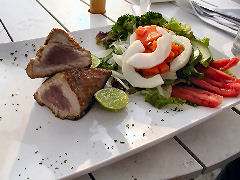 Trujillo, Peru – Having left behind Cuzco and the home of the Incas, we found ourselves an hour or so later in Lima with several hours to wait until the one daily flight to Trujillo, Henry’s hometown. We checked our luggage into a locker and grabbed a cab to the beach, where we sat at a beachside restaurant, Punta Blanca, and enjoyed the waves and wind along with a little fresh roasted tuna. Real red tuna, not the stuff that we get in Buenos Aires that’s referred to as tuna but probably is unrelated other than being a fish. And not canned. Just delicious, juicy, perfectly cooked, and accompanied by a fresh vegetable salad. How nice is that? And at the beach… which we’ve been looking forward to, and more about which in my posts on Trujillo, as well, I imagine, when we return to Lima on this coming Sunday.
Trujillo, Peru – Having left behind Cuzco and the home of the Incas, we found ourselves an hour or so later in Lima with several hours to wait until the one daily flight to Trujillo, Henry’s hometown. We checked our luggage into a locker and grabbed a cab to the beach, where we sat at a beachside restaurant, Punta Blanca, and enjoyed the waves and wind along with a little fresh roasted tuna. Real red tuna, not the stuff that we get in Buenos Aires that’s referred to as tuna but probably is unrelated other than being a fish. And not canned. Just delicious, juicy, perfectly cooked, and accompanied by a fresh vegetable salad. How nice is that? And at the beach… which we’ve been looking forward to, and more about which in my posts on Trujillo, as well, I imagine, when we return to Lima on this coming Sunday.
I’m going to approach Trujillo, the city of Eternal Spring, a bit differently than the rest of this trip. First, we weren’t here primarily to see sites, archaeological or modern. We’re here for a family visit, which is a whole other kettle of fish as they say. So I’m going to divide it up sort of by category rather than by day… site seeing, family, the city, food… I may as well get the site seeing part over with, since we did very little of it, and I don’t expect we’ll be doing any more. Trujillo is located in the heart of the northern coast, in what was once, long before the Incas, the territory of the Moche, and then later the Chimu, cultures… we’re talking about a period from around 1000 to 1500 years ago, as opposed to the Incan culture, which was really centered around 500-600 years ago. The entire north coast is scattered with archaeological sites, and one could spend weeks exploring them all, from as far south as nearly to Lima to as far north as the border with Ecuador – several hundred miles.
Closest to the city of Trujillo are two prime locales that are considered the major ruins of the period. The Huacas del Luna y del Sol, or Temples of the Moon and the Sun, are the remains of the Moche culture. They’re both under study right now, and only the temple of the moon is accessible to the public – the sun temple has yet to be fully excavated, and sits like a mud covered hill in the nearby valley. A good portion, though not all, of the moon temple has been uncovered, and there are teams of archaeologists and students currently working on the site fulltime. For a modest fee of 11 soles a person, one of the students will take you on a guided tour of the areas that have been more well studied, and protected from the elements… and visitors. The amount of uncovered detail is pretty amazing – but then, the entire temple was buried under a mound of sand and protected from the elements for more than a millenium.
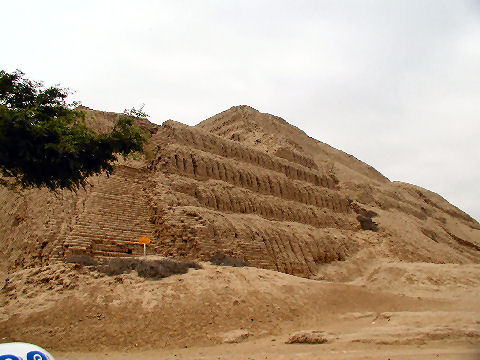
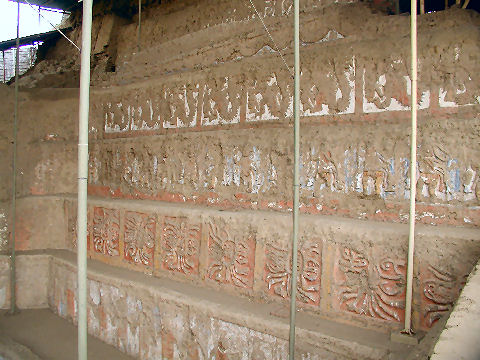
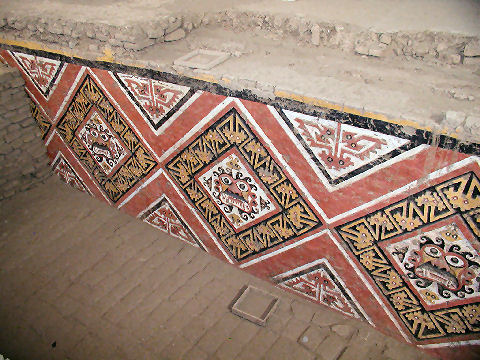
On another day, we visited what’s usually considered the most important local site, Chan Chan. This, assuming my memory isn’t so overwhelmed with historical trivia, was the main city of the Chimu culture. Most of what remains are crumbling packed mud walls, and there are vast stretches of them all over the northwest of the city. Chan Chan was big, bigger actually than Trujillo is now. The two main spots of interest when touring it are the Huaca Arco Iris, or Rainbow Temple, also referred to as the Dragon Temple, though that’s probably a fanciful misnomer, as there doesn’t seem to be any evidence of dragon legends from the Chimu culture – more of a misinterpretation of serpent symbols in the temple; and the other is the Palacio Tschudi, named, I gather, after a Swiss archaeologist who attached his name to it after uncovering it. The entire area is still under excavation and study, but this palace is one of the few remaining structures that still has enough detail to be of interest to visitors.
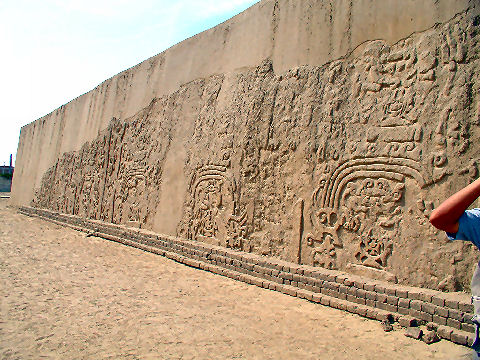
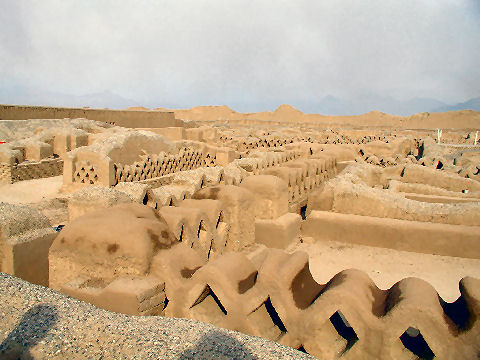
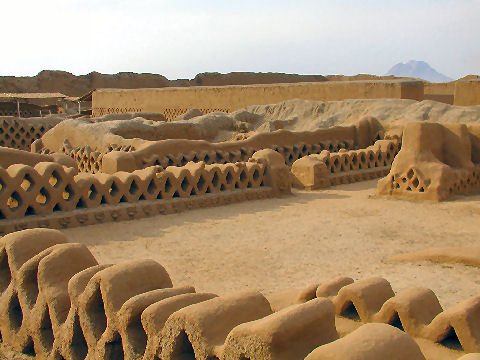
[…] on to spend a few days at the family homestead. Now, those of you who’ve been with me awhile will perhaps remember that the homestead is… well… not exactly what I’m used to, let’s just say […]
[…] father asks, I’m not going to lie, and left the visit up to him). Anyway, you can see back to my first visit here, and the second series of posts here. So I’m not going to repeat a lot of what I’ve […]
Thanks for the Peruvian posts. I read the July 2013 one first, then this one, and will move on to #2 next. My b.f. is from Trujillo and worked as an archeologist’s assistant reapplying mud to parts of Chan Chan. We’re going to Trujillo, Lima and Cuzco next month for a quick visit and then next year for a longer time. Your descriptions of the food you’ve had ring true to Carlos. And we too will be in Trujillo for a family visit — my first time meeting them. Keep up with the writing, please; we love it.
Ron and Charly
p.s. I sent your link and a copy of the paragraph about kid offal to my friend Jennifer Maclagan in Toronto, where I live half time. While she was writing her book “Odd Bits” I was able to do a tiny amount of research here in BsAs — mainly stuffing myself with the kinds of dishes she wanted to know about, and being a home cook trying to use her great recipes. I’m going to have to hunt down that chirimpico/sangrecito and report back to her.
ron
[…] Saranjada (white beans in leche de tigre), seco de pato (braised duck), cecinas (basically pork jerky “stew”) at a roadside stand near the huacas. […]